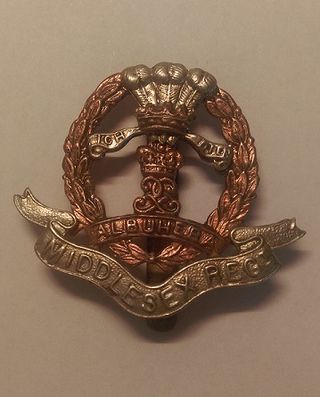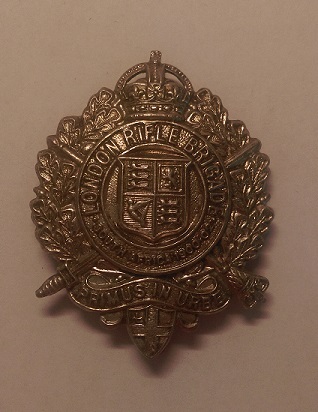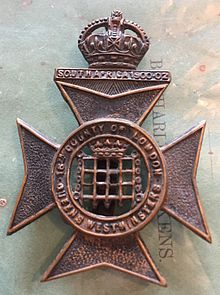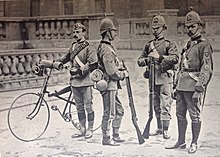
The King's Royal Rifle Corps was an infantry rifle regiment of the British Army that was originally raised in British North America as the Royal American Regiment during the phase of the Seven Years' War in North America known in the United States as 'The French and Indian War.' Subsequently numbered the 60th Regiment of Foot, the regiment served for more than 200 years throughout the British Empire. In 1958, the regiment joined the Oxfordshire and Buckinghamshire Light Infantry and the Rifle Brigade in the Green Jackets Brigade and in 1966 the three regiments were formally amalgamated to become the Royal Green Jackets. The KRRC became the 2nd Battalion, Royal Green Jackets. On the disbandment of the 1st Battalion, Royal Green Jackets in 1992, the RGJ's KRRC battalion was redesignated as the 1st Battalion, Royal Green Jackets, eventually becoming 2nd Battalion, The Rifles in 2007.

The Rifle Brigade (The Prince Consort's Own) was an infantry rifle regiment of the British Army formed in January 1800 as the "Experimental Corps of Riflemen" to provide sharpshooters, scouts, and skirmishers. They were soon renamed the "Rifle Corps". In January 1803, they became an established regular regiment and were titled the 95th Regiment of Foot (Rifles). In 1816, at the end of the Napoleonic Wars, they were again renamed, this time as the "Rifle Brigade".
The British Army is listed according to an order of precedence for the purposes of parading. This is the order in which the various corps of the army parade, from right to left, with the unit at the extreme right being highest. Under ordinary circumstances, the Household Cavalry parades at the extreme right of the line. Militia and Army Reserve units take precedence after Regular units with the exception of The Honourable Artillery Company and The Royal Monmouthshire Royal Engineers.

The 30th Armoured Brigade was an armoured formation of the British Army that served in Western Europe Campaign as part of the 79th Armoured Division. After the reformation of the Territorial Army in 1947, the brigade was re-created within the Territorials based in Scotland and finally disbanded by 1967.
The 131st Infantry Brigade, originally the Surrey Brigade was an infantry formation of Britain's Territorial Army that saw service during both the First and the Second World Wars. In the First World War the brigade was in British India for most of the war and did not see service as a complete unit but many of its battalions would see service in the Middle East.

The 10th Armoured Division was an armoured formation of division-size of the British Army, raised during the Second World War and was active from 1941–1944 and after the war from 1956–1957. It was formed from the 1st Cavalry Division, a 1st Line Yeomanry unit of the Territorial Army (TA) which had previously been serving in Palestine. The division was converted from cavalry to armour and redesignated from 1 August 1941.

The Middlesex Regiment (Duke of Cambridge's Own) was a line infantry regiment of the British Army in existence from 1881 until 1966. The regiment was formed, as the Duke of Cambridge's Own (Middlesex Regiment), in 1881 as part of the Childers Reforms when the 57th (West Middlesex) and 77th (East Middlesex) Regiments of Foot were amalgamated with the county's militia and rifle volunteer units.

The Border Regiment was a line infantry regiment of the British Army, which was formed in 1881 under the Childers Reforms by the amalgamation of the 34th (Cumberland) Regiment of Foot and the 55th (Westmorland) Regiment of Foot.
The 9th Battalion, London Regiment was a Territorial Army infantry battalion of the British Army. The London Regiment was formed in 1908 in order to regiment the various Volunteer Force battalions in the newly formed County of London, and the Queen Victoria's Rifles were one of twenty six units brought together in this way.

The Fife and Forfar Yeomanry (FFY) was an Armoured Yeomanry Regiment of the British Army formed in 1793. It saw action in the Second Boer War, the First World War and the Second World War. It amalgamated with the Scottish Horse to form the Fife and Forfar Yeomanry/Scottish Horse in 1956. The lineage is maintained by "C" Fife and Forfar Yeomanry/Scottish Horse Squadron of The Scottish and North Irish Yeomanry based in Cupar in Fife.

The 3rd County of London Yeomanry (Sharpshooters) was a Yeomanry regiment of the British Army. It was raised in 1901 from Second Boer War veterans of the Imperial Yeomanry. During the First World War it served dismounted at Gallipoli, was remounted to serve in Macedonia, Egypt and Palestine, before being converted to machine gunners for service on the Western Front. 2nd and 3rd Line units remained in the United Kingdom throughout.
The 168th Brigade was an infantry brigade formation of the British Army that saw service during both the First and the Second World Wars. Throughout its existence, serving under many different titles and designations, the brigade was an integral part of the 56th (London) Infantry Division. It served on the Western Front during First World War and in the Italian Campaign during the Second World War. It was finally disbanded in the 1960s.
The 156th Brigade was an infantry brigade formation of the British Army. The brigade saw active service in both the First and the Second World Wars with the 52nd (Lowland) Infantry Division.
The 155th Brigade was an infantry brigade of the British Army that saw active service in both the First and the Second World Wars. Assigned to the 52nd (Lowland) Division, the brigade saw active service in the Middle East and on the Western Front during the First World War. During the Second World War, now the 155th Infantry Brigade, it continued to serve with the 52nd Division in Operation Dynamo, and later in North-western Europe from late 1944 until May 1945.

The 140th Brigade was an infantry brigade formation of the British Army's Territorial Army (TA) that had its origins in a South London Brigade of the former Volunteer Force. It served on the Western Front in the First World War and was recreated during the Second World War where it served only in the United Kingdom as a training formation.
The 169th Brigade was an infantry brigade of the British Army that saw active service in both the First and the Second World Wars. Throughout its existence the brigade, serving under numerous many different titles and designations, was an integral part of the 56th (London) Infantry Division. It served on the Western Front in the First World War, and in the North African and Italian campaigns during the Second World War.

The Monmouthshire Regiment was a Territorial infantry regiment of the British Army. Originating in units of rifle volunteers formed in Monmouthshire in 1859, the regiment served in the Second Anglo-Boer War and both World War I and World War II before losing its separate identity in 1967.

The 17th Battalion, The London Regiment , was a unit of Britain's Territorial Force formed in 1908 from Volunteer corps dating back to 1859. It saw considerable service on the Western Front, at Salonika and in Palestine during World War I. It served as an infantry regiment during World War II before conversion to an artillery unit in 1947 and subsequent amalgamation in 1967.

The London Rifle Brigade was a volunteer regiment of the British Army.

23rd Battalion, London Regiment was a battalion of the London Regiment (1908-1938), based at the St John's Hill Drill Hall in Lavender Hill, south London. It served as a Tank Regiment during the Second World War, but reverted to Infantry in the Territorial Army in 1956, when it became a Territorial Battalion of the East Surrey Regiment. In 1961 it was amalgamated to form the 4th (Territorial) Battalion of the Queen's Royal Surrey Regiment.

















